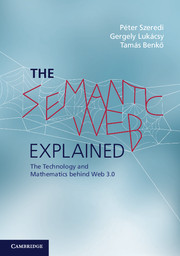1 - The World Wide Web today
Published online by Cambridge University Press: 05 August 2014
Summary
The aim of this chapter is to introduce some major problems associated with the World Wide Web that have led to the development of its new generation, the Semantic Web.
The chapter has two main parts. In the first we describe the structure of the Internet, the different kinds of web pages (static and dynamic) and their role in the process of information storage. Here we also introduce the concept of web forms and Common Gateway Interface (CGI) technology and its more advanced alternatives.
In the second part of the chapter we examine how traditional search engines work, what their limits are and how they fare with heterogeneous information sources. We illustrate the problems associated with searching the Web and briefly describe possible solutions. One of these is the Semantic Web approach, which is described in more detail in later chapters.
For readers familiar with the Internet we suggest skipping the first section and starting at Section 1.2.
The architecture of the web
The World Wide Web is made up of servers and clients. Servers store different kinds of information in various ways. Most often these pieces of information are stored in the form of web pages (also called homepages), which are essentially standard text files with a special structure.
Information
- Type
- Chapter
- Information
- The Semantic Web ExplainedThe Technology and Mathematics behind Web 3.0, pp. 9 - 51Publisher: Cambridge University PressPrint publication year: 2014
